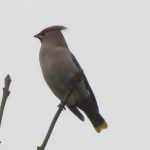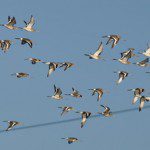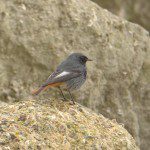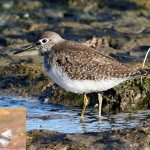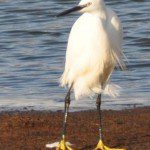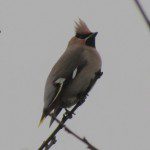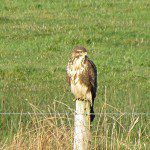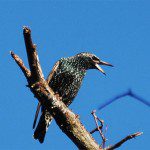15th January 2011
NB: The following is reproduced by kind permission of Axe Estuary Birds. Full credit goes to the team that produces the newsletter (see the bottom of the post for specific details). Photographs are credited throughout the text although we are working to preserve the original layout wherever possible in the future.
The Birds
2010 was a memorable birding year. Steve Waite may not be contributing to this newsletter direct any more, but his blog has recorded some of the highlights First, of course, the Solitary Sand-piper at Black Hole Marsh, which brought birders from all over the country, a first for Devon. The Long-billed Dowitcher at Boshill Cross, another patch first, the greyish Yellow Wagtail at the Colyton Water Treatment Works, a Bittern and two Bearded Tits at Colyford Common, an Alpine Swift over Musbury, a Dotterel at Axe Cliff, a “stonking” Glaucous Gull in November and both Whooper and Bewick Swans. Photo Brett
And Steve is still very active, as this extract from his blog shows. “ Five Velvet Scoters had been seen off the sea front earlier on 1st January, so I headed here first. I was pleasantly surprised to see there were now eight Velvet Scoters loosely associating with the flock of 42 Common Scoter – all female-types (the Velvets not the Commons!). Two Brent Geese flew in from the east and landed with the Scoters, a Jan 1st bonus! I also logged three Red-throated Divers and several Razorbills.”
In addition, Ian Mclean has seen up to seven Red-throated Divers, a Tufted Duck, two Pintail, ten Kittiwake and
15 Great Crested Grebe in Seaton Bay, and Peter Mason reports a Common Tern off Seaton Beach on January 3rd.
Bob Olliver has sent the following snippets from the Colyford Common log book for the first week of the year:- Canada Geese numbers reached 50 but there were no large counts of wildfowl, and a Goose which turned out to be a Greylag, opposite Stedcombe House. Lapwing numbers reached 585, with one Golden Plover, and there was a high count of 71 Snipe on the Marsh, single Green Sandpipers were noted, and another on the Marsh. Two Rock Pipits were there on 7th and also the first Water Pipit of the year. The only record of winter thrushes was of ten Redwing on and elsewhere locally literally thousands of Lapwing have been seen. There were four Little Grebes on the reserve plus two on the river on 6th and a Water Rail on the reserve on 1st.
At Lower Bruckland Ponds Mike Lock saw up to 13 Tufted Duck, a pair of Pochard, four Little Grebes and several Coots. He also had no less than ten Greenfinches in his garden together with six Goldfinches.
Karen Woolley “Popped over to Seaton Hole today to see if the male Black Redstart which Bun found there on Tuesday was still around. He was. What a stunning little chap he is too.”
Photo Karen Woolley
Up to now, Waxwings have been elusive on our patch, although a small flock was reported in trees near the cemetery, and Rodney Gayer saw seven near the Cloakham Lawns sports centre SY300993, on 11th January, and in spite of poor light Sue Smith took lots of photos on 12th. They were still there on 13th. Does any one know why they are called “Wax”wings?
Waxwings – Punk and Posh – Sue Smith
Pride of place for the first week of the New Year must go to the Bittern, seen briefly at Black Hole Marsh on 4th January.
Rodney Gayer from Axminster also reports that on 10th January, there was a female-type Goosander fishing on the river Axe between Cloakham Lawns and Weycroft Bridge. He thinks it may be one of the two birds that were present for much of December.
These Godwits were snapped by Sue Smith at Black Hole Marsh, and this Buzzard was there too, although continually harried by Carrion Crows.
Ringing
On 8th January at the catching site at its peak only 14 birds could be found (including five Moorhens) whereas the day before there were c.60. Eventually after a patient wait we were able to fire on eight birds which included 2 Shelduck,
5 Wigeon and 1 Moorhen. What a contrast to the last session of 2010 when 191 birds were ringed.
The group had its best year last year with 787 new birds ringed and a total processed of 1,150 of 37 varieties.
News from Holyford Woods
Jean reports “ I was walking Paco along White Gate Lane late one dusky evening at the weekend, when I watched three huge flocks of what sounded to be only Jackdaws fly in from the North, West and East, converging over Pratts Hill. They swirled round for a while, calling loudly all the time, before suddenly swooping down in to the Western end of Holyford Woods to roost. There must have been at least 500 to 600 birds in total. An amazing sight and sound.
I have never seen or heard anything like it. The sound of all that ‘jacking’ was really loud. It was so like the gathering of the starlings. I have not had a chance to go there again to see if it is still happening.
The effects of the snow can be seen everywhere in the woods. The brambles and dead bracken was weighed down, and ferns, apart from the Hart’s Tongue, were broken off. This has given an unusual open view across the floor of the wood, so down by the stream and on the Hangings, 3 Roe Deer were easy to spot without Paco’s help. Sadly he found a freshly dead Doe just off the path, which had already provided a meal for a Fox. The overlapping of the seasons is very evident already. Spring is well on its way. There is a noticeable increase in small bird activity and calls, in particular Great Tits, and the Rooks have started inspecting last year’s nests. 2 Buzzards are floating on the thermals again and 2 Ravens are swooping and wheeling together. Hazel trees are loaded with catkins about to produce pollen with the pussy willow buds filling out and honeysuckle leaves well advanced. Underfoot primroses are throwing up fresh leaves, as are the foxgloves. Following the thaw there is a wonderful display of bright green mosses. Soon I should be doing a frog spawn count. The first few clumps appeared in the first week of February last year.” Jean Kreiseler.
The Trivia
Just a few years ago the sighting of a Little Egret would have caused considerable excitement, but now, as Sue Smith says, it is a somewhat neglected bird. She “just loves his feet !”
Another neglected but very fine bird is the Starling, this one snapped by Simon Wakely in his garden.
Have a look at this: http://www.38degrees.org.uk/page/s/save-our-forests The government is floating plans to sell off our national forests to private firms. Please consider signing the petition.
Don’t forget the RSPB Big Garden Birdwatch on the 29th and 30th January. Just spend one hour counting numbers and species of bird landing in your garden, and fill in the form at http://www.rspb.org.uk/birdwatch.
This twice-monthly email newsletter is freely available to anyone who would like it, as is a periodic one about the activities of the East Devon Local Group of the Devon Wildlife Trust. Just send me an email with Axe Estuary Birds and/or East Devon DWT in the subject line. Also, for those without a computer, I will send a copy by post if you would like to send me some stamps.
Thanks to those who keep me informed. Please continue to tell me of any unusual, interesting or amusing sightings, and what is about locally, and send any photos you would like to share.
Mike, Jean, and David. (and many others!) davidwalters@eclipse.co.uk. tel. 01297 552616 Mobile 0779 1541 744.

